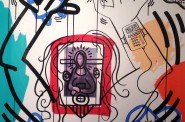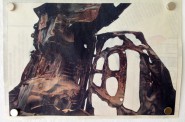The Etchings of Rembrandt
A gift for UWM's art collection offers a glimpse into the Dutch Golden Age of connoisseurship.
Rembrandt is synonymous with artistic Old Masters. The name conjures images of luminous light and dark, investing scenes of ordinary life as well as Biblical stories with high drama.
In his day, Rembrandt was quite successful and particularly well-known for his prints. His legendary skill endures. As art historian and author B. P. J. Broos notes, “He has probably never been surpassed as an etcher.”
A multimillion-dollar bequest to the University of Wisconsin-Milwaukee Art Collection from the estate of Racine art collector Emile H. Mathis II offers a chance for a unique study of this artist’s work. Rembrandt Etchings: States, Fakes, and Restrikes, brings together prints from the master’s own hand, later editions, and some outright forgeries for comparison.
Rembrandt van Rijn (Dutch, 1606-1669) was very much a man of his day. He created art in accordance with the taste of the contemporary market for religious subjects, portraits, and scenes of ordinary life. The 17th century was known as the Dutch Golden Age, when trade and industry created wealth and a prosperous society in the Netherlands. With that came a taste for art, and artists such as Rembrandt to supply it.
Professional artists often made prints, which could be reproduced in multiples for lower cost and less effort than a singular painting. Rembrandt made the etchings by drawing on a metal plate coated with an acid-resistant material. As the artist draws the composition, the metal underneath the coating is exposed. Acid is then applied to the plate, which eats into the exposed surface and creates grooves. Once the artist’s lines are chemically incised on the plate, ink is applied and the excess cleaned away so ink remains only in the etched grooves. The inked plate meets paper on a printing press to transfer the image.
Magnifying glasses are supplied for viewing, and these will open up this extraordinary world of discreet nuance. Getting up-close-and-personal is the most rewarding way of seeing this exhibition, as virtuosic turn of lines from the hands of Rembrandt come to life. Especially in the freshest, first states, there is a vivacity of line, a bounce and surety in contour and the casting of light and shade. The loss of detail in later editions becomes clearer, and the difference in the handling of a forger may appear notably ham-fisted.
A number of extraordinary and even entertaining images appear in this exhibition. Particularly impressive is Joseph and Potiphar’s Wife, a Biblical scene originally printed in 1634. Nearly 400 years after it was made, the diminutive picture carries a psychic force as the lusty Potiphar struggles to seduce Joseph, who is disgusted by her advance. He resists mightily as she writhes lasciviously. In the background, Rembrandt wove a nearly impenetrable pattern of the densest, deepest black lines, a shroud of misfortune over Potiphar’s bed.
In the more lighthearted is The Golf Player — a late-20th-century restrike of a 1654 plate — Outside a tavern, a Dutchman ready for a bit of sport ambles by a tavern in bright sunlight. Inside, a swarthy fellow indolently lounges at a table, with one leg thrown over the bench. His expression suggests readiness for a drink or a duel. At times, Rembrandt is as much psychological documentarian as artist.
Student at Table by Candlelight dates to 1642, but the intensity of the intellectual life, here with open book and burning oil lamp, is timeless. This print is really quite curious, as underneath the lamp is a pattern of rounded shadows. The construction of their lines is magical and elusive as quicksilver even under magnification, as they somehow morph in and out of focus.
By the way, one of Rembrandt’s masterpiece self-portraits will be on view at the Milwaukee Art Museum, beginning in October. Until then, this is a satisfying, illuminating introduction to his art and to the debate concerning authenticity of some works. But most particularly, this exhibition serves as a brief introduction to the art of connoisseurship and the intimate vision of Rembrandt in his time.
“Rembrandt Etchings: States, Fakes, and Restrikes” is on view in the UWM Art History Gallery through September 27th, 2012.
The gallery is located on the UWM Campus in Mitchell Hall, Room 154, 3203 N. Downer Avenue. Hours are Monday-Thursday, 10 a.m.-4 p.m.
Professor Tanya Tiffany will give a talk on the exhibition at 4 p.m. Thursday, Sept. 20, in the gallery.
Get more out of TCD. Check out our User Guide/FAQ.
Art
-
It’s Not Just About the Holidays
 Dec 3rd, 2024 by Annie Raab
Dec 3rd, 2024 by Annie Raab
-
After The Election Is Over
 Nov 6th, 2024 by Annie Raab
Nov 6th, 2024 by Annie Raab
-
The Spirit of Milwaukee
 Aug 30th, 2024 by Annie Raab
Aug 30th, 2024 by Annie Raab
Art Date
-
Apocalypse Now
 May 30th, 2014 by Kat Murrell
May 30th, 2014 by Kat Murrell
-
Slower Than a New York Minute
 May 16th, 2014 by Kat Murrell
May 16th, 2014 by Kat Murrell
-
Easy Rider
 May 9th, 2014 by Kat Murrell
May 9th, 2014 by Kat Murrell





















[…] and scenes of ordinary life. The 17th century was known as the Dutch Golden … Read more on ThirdCoast Digest This entry was posted in Taste Of Ink and tagged Arts, Dining, Fall, Preview. Bookmark the […]
[…] Weekend Art Date: The Etchings of Rembrandt Rembrandt is synonymous with artistic Old Masters. The name conjures images of luminous light and dark, investing scenes of ordinary life as well as Biblical stories with high drama. In his day, Rembrandt was quite successful and particularly well … Read more on ThirdCoast Digest […]